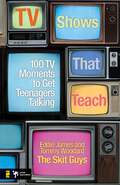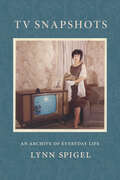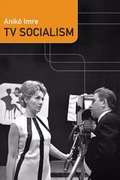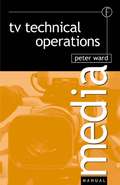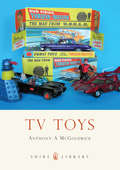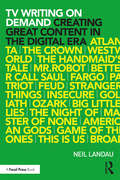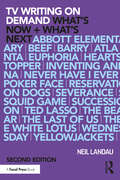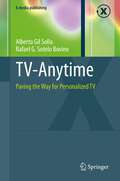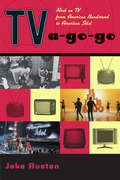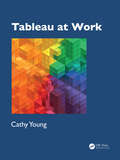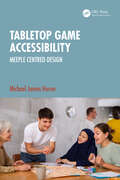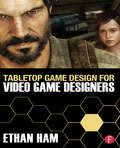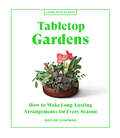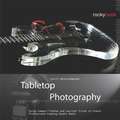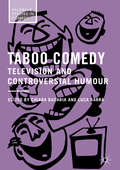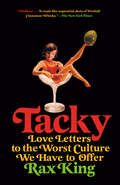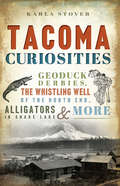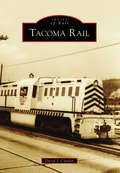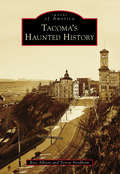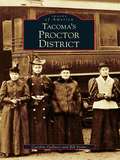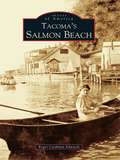- Table View
- List View
TV Shows That Teach: 100 TV Moments to Get Teenagers Talking (Videos That Teach)
by Eddie James Tommy WoodardWe've all heard the statistics about how much TV kids watch-and how it's not good for them. Well, throw those stats out the window so you can use TV for the good of your students! Following the best-selling format of the Videos That Teach series, TV S
TV Shows and Nonplace: Why The Sopranos, Breaking Bad and Co. Love the Periphery (Routledge Focus on Television Studies)
by Alexander GutzmerThis book scrutinizes the relationship between contemporary TV shows and space, focusing on the ways in which these shows use and narrate specific spatial structures, namely, spaces far away from traditional metropolises. Beginning with the observation that many shows are set in specific spatial settings, referred to in the book as “nonplace territories” – e.g., North Jersey, New Mexico, or rural and suburban Western Germany – the author argues that the link between such nonplace territories and shows such as The Sopranos, Breaking Bad, or Dark is so intense because the narrative structure functions similarly to these territories: flat, decentralized, without any sense of structure or stable hierarchy. The book takes three different perspectives: first, it looks at the rationale for combining TV shows and nonplace territories from the viewpoint of narrative strategy. It then thinks through what these strategies mean for practicing architects. Finally, it approaches the arguments made before from a “user” perspective: what does this narrative mirroring of social-spatial reality in places such as Albuquerque or Jersey City mean for people living in these places? This new approach to architecture and space on screen will interest scholars and students of television studies, screen architecture, media and architectural theory, and popular culture.
TV Snapshots: An Archive of Everyday Life
by Lynn SpigelIn TV Snapshots, Lynn Spigel explores snapshots of people posing in front of their television sets in the 1950s through the early 1970s. Like today’s selfies, TV snapshots were a popular photographic practice through which people visualized their lives in an increasingly mediated culture. Drawing on her collection of over 5,000 TV snapshots, Spigel shows that people did not just watch TV: women used the TV set as a backdrop for fashion and glamour poses; people dressed in drag in front of the screen; and in pinup poses, people even turned the TV setting into a space for erotic display. While the television industry promoted on-screen images of white nuclear families in suburban homes, the snapshots depict a broad range of people across racial, ethnic, and class backgrounds that do not always conform to the reigning middle-class nuclear family ideal. Showing how the television set became a central presence in the home that exceeded its mass entertainment function, Spigel highlights how TV snapshots complicate understandings of the significance of television in everyday life.
TV Socialism
by Anikó ImreIn TV Socialism, Anikó Imre provides an innovative history of television in socialist Europe during and after the Cold War. Rather than uniform propaganda programming, Imre finds rich evidence of hybrid aesthetic and economic practices, including frequent exchanges within the region and with Western media, a steady production of varied genre entertainment, elements of European public service broadcasting, and transcultural, multi-lingual reception practices. These televisual practices challenge conventional understandings of culture under socialism, divisions between East and West, and the divide between socialism and postsocialism. Taking a broad regional perspective encompassing Eastern Europe and the Soviet Union, Imre foregrounds continuities between socialist television and the region's shared imperial histories, including the programming trends, distribution patterns, and reception practices that extended into postsocialism. Television, she argues, is key to understanding European socialist cultures and to making sense of developments after the end of the Cold War and the enduring global legacy of socialism.
TV Technical Operations: An introduction (Media Manuals Ser.)
by Peter WardTV Technical Operations is an introduction for new entrants to the broadcast industry and is designed to prepare them for working in mainstream television by discussing essential techniques, technologies and work attitudes. The author explores:* the need to develop a professional approach* the occupational skills needed to meet deadlines, work under pressure and within budget* the importance of understanding the potential of broadcast equipment in program making* the need to keep up to date with the technique and technology* the responsibility to ensure continuity of experience and training in all craft skills that technical operators are required to work with* the need to maintain a critical appraisal of what and who influences working practices and how these influences affect production and viewers* an introduction to the basic skills needed to work as a multi-skilling technical operator in television* an introduction to broadcast equipment in general production usePeter Ward is a freelance cameraman and camerawork trainer working with international training and television consultancy. He was formerly head of cameras at Television South West.
TV Toys
by Anthony McgoldrickThis book tells the story of toys based on TV programs (both from the US and Britain), and how these much-loved objects evolved over the years since the 1930s, through the 'golden age' of children's TV in the 1960s and 1970s, and then onto the 1980s until now, including Pinky & Perky, Magic Roundabout, The Man from UNCLE, Batman, Thunderbirds, The A-Team, Doctor Who, and Teenage Mutant Ninja Turtles.
TV Writing On Demand: Creating Great Content in the Digital Era
by Neil LandauTV Writing On Demand: Creating Great Content in the Digital Era takes a deep dive into writing for today’s audiences, against the backdrop of a rapidly evolving TV ecosystem. Amazon, Hulu and Netflix were just the beginning. The proliferation of everything digital has led to an ever-expanding array of the most authentic and engaging programming that we’ve ever seen. No longer is there a distinction between broadcast, cable and streaming. It’s all content. Regardless of what new platforms and channels will emerge in the coming years, for creators and writers, the future of entertainment has never looked brighter. This book goes beyond an analysis of what makes great programming work. It is a master course in the creation of entertainment that does more than meet the standards of modern audiences—it challenges their expectations. Among other essentials, readers will discover how to: Satisfy the binge viewer: analysis of the new genres, trends and how to make smart initial decisions for strong, sustainable story. Plus, learn from the rebel who reinvented an entire format. Develop iconic characters: how to foster audience alignment and allegiance, from empathy and dialogue to throwing characters off their game, all through the lens of authenticity and relatability. Create a lasting, meaningful career in the evolving TV marketplace: how to overcome trips, traps and tropes, the pros and cons of I.P.; use the Show Bible as a sales tool and make the most of the plethora of new opportunities out there. A companion website offers additional content including script excerpts, show bible samples, interviews with television content creators, and more.
TV Writing On Demand: What's Now + What's Next.
by Neil LandauThis book takes a deep dive into writing for today’s audiences, against the backdrop of a constantly evolving TV ecosystem.The aim of this 2nd edition is to go beyond an analysis of what makes exceptionally compelling episodic TV series work. It is a master course in the creation of entertainment that does more than meet the standards of modern audiences – it challenges their expectations.The book will help readers discover how to satisfy the satiated viewer, by analyzing the new hybrid genres, trends, and how to make smart initial decisions for a strong, sustainable story. It will also cover the development of iconic characters that foster empathy and entice viewers to bond with characters and generate the sensation that their problems are mutual.Finally, the book will also take a deep dive into creating a lasting, meaningful career in the TV marketplace, by overcoming trips, traps and tropes, the pros and cons of IP, the use of pitch documents, pitch decks, and show “bibles” as proof-of-concept in the marketplace.This will be an essential resource for student and professional writers and is supplemented with a companion website offering additional content, including script excerpts, pitch document/deck/show bible samples, scene analysis and templates, plus useful writing exercises to break new ground and to mine new territory.
TV-Anytime
by Rafael G. Sotelo Bovino Alberto Gil SollaTelevision is a mature mass media with close to eight decades of regular broadcasts since its beginnings in Germany, the UK and the USA. Today, despite the spectacular growth of the Internet and social networks, television is still the leading medium for entertainment and information across the world, exerting an unparalleled influence on public opinion. Until recently television had undergone a rather slow evolution regarding the interaction with its users, yet this is beginning to change. The ongoing trend of digitalization has accelerated the process, and the computational capacity of televisions and set-top boxes has increased the possibilities of communication and implementation of services. This book provides the first descriptive and structured presentation of the TV-Anytime norm, which will standardize information formats and communication protocols to create a framework for the development of novel and intelligent services in the audiovisual market. The standard, the dissemination of which has been entrusted to the European Telecommunications Standards Institute, ensures manufacturers and service providers that their products will be presented to the widest possible market, without fear of being constrained by the wars of interest typical for emerging technologies. The individual chapters provide detailed descriptions of the new standard's most important capabilities and contributions, including metadata management, customization and personalization processes, uni- and bidirectional data transfer, and remote receiver programming. Overall, the authors deliver a solid introduction to the standard. To ensure a better understanding of concepts and tools, they present a wide range of simple examples illustrating many different usage scenarios that can be found when describing users, equipment and content. This presentation style mainly targets professionals in the television and broadcasting industry who are interested in acquainting themselves with the standard and the possibilities it offers.
TV-a-Go-Go: Rock on TV from American Bandstand to American Idol
by Jake AustenFrom Elvis and a hound dog wearing matching tuxedos and the comic adventures of artificially produced bands to elaborate music videos and contrived reality-show contests, television--as this critical look brilliantly shows--has done a superb job of presenting the energy of rock in a fabulously entertaining but patently "fake" manner. The dichotomy of "fake" and "real" music as it is portrayed on television is presented in detail through many generations of rock music: the Monkees shared the charts with the Beatles, Tupac and Slayer fans voted for corny American Idols, and shows like Shindig! and Soul Train somehow captured the unhinged energy of rock far more effectively than most long-haired guitar-smashing acts. Also shown is how TV has often delighted in breaking the rules while still mostly playing by them: Bo Diddley defied Ed Sullivan and sang rock and roll after he had been told not to, the Chipmunks' subversive antics prepared kids for punk rock, and things got out of hand when Saturday Night Live invited punk kids to attend a taping of the band Fear. Every aspect of the idiosyncratic history of rock and TV and their peculiar relationship is covered, including cartoon rock, music programming for African American audiences, punk on television, Michael Jackson's life on TV, and the tortured history of MTV and its progeny.
Tableau at Work
by Cathy YoungWith data and AI increasingly at the forefront of business today, you have a significant advantage when you can manage data, and uncover and communicate data insights effectively. By thoroughly cataloging, indexing, and cross-referencing material, this book flattens the steep Tableau learning curve, starting you on your data journey and serving as a comprehensive reference and study guide. Where do I start with Tableau? How do I prepare and connect to data files that are constantly changing? How do I share Tableau files with co-workers, and what is tall data? How do I test whether the calculations and aggregations are correct? How can I create vibrant charts with sorting, color, axis labels, annotations, mark labels, trend lines, tooltips, or reference lines? The book includes over 60 worksheets and guides to deliver 40 quality charts and dashboards. In addition, there are another 60 focused and on-point examples, covering everything from context filters and weighted average calculations to transparent shapes and colors with placeholder fields. Similarly, nine step-by-step dashboard guides illustrate parameters, containers, buttons, actions, and more. With over 800 diagrams and images, clear explanations are provided for concepts including: Measures and Dimensions; Discrete vs. Continuous; Aggregation; Joins, Blends, and Relationships; Order of Operations; Mark Types and Color, Size, Text, Detail, and Tooltip Tiles; Actions, Sets, Links, Highlighting, and Parameters; Reference Lines and Trend Lines; Dashboard Layout, Containers, Filtering, and Interactivity.Tableau at Work is the perfect book for anyone who wants a comprehensive guide and reference to Tableau, from beginners and novices all the way to advanced and professional users. Many of the Tableau workbooks can be downloaded from the author’s Tableau Public profile and for more information you can also visit the author's website (www.TableauAtWork.com).
Tabletop Game Accessibility: Meeple Centred Design
by Michael James HeronThis foundational resource on the topic of tabletop game accessibility provides actionable guidelines on how to make games accessible for people with disabilities. This book contextualises this practical guidance within a philosophical framework of how the relatively abled can ethically address accessibility issues within game design.This book helps readers to build understanding and empathy across the various categories of accessibility. Chapters on each category introduce ‘the science’, outline the game mechanics and games that show exemplar problems, relate these to the real-world situations that every player may encounter, and then discuss how to create maximally accessible games with reference to the accessibility guidelines and specific games that show ‘best-in-class’ examples of solutions.This book will be of great interest to all professional tabletop and board game designers as well as digital game designers and designers of other physical products.
Tabletop Game Design for Video Game Designers
by Ethan Ham<p>Learn the mechanics that take your game from an idea to a playable product. <p>Do you aspire to be a game designer but aren’t sure where to begin? Tabletop Game Design for Video Game Designers guides you through your initial attempts to design game mechanics. It goes beyond simple description and definition to explore in detail the issues that designers grapple with for every game they create. <p>Learning to design tabletop games builds a solid foundation for game designers and provides methods that can be applied towards creating paper prototypes of computer-targeted games. Presented in a step-by-step format, Tabletop Game Design for Video Game Designers helps the reader understand how the game design skills that are acquired through creating tabletop games can be used when designing video games. Fully playable games accompany every topic so you can truly understand and experience each component that goes into game creation. <p>Tabletop Game Design for Video Game Designers includes: <p> <li>Simple, highly focused games that can be played, analyzed, improved, and/or modified in conjunction with a particular topic in the book. <li>Integrated game design exercises, chapter learning objectives, and in-text sidebars to provide further examples to apply directly to your game creation process. <li>A companion website (www.funmines.com) which includes: "print & play" tabletop games, links to online games, game design resources, and articles about designing and developing games.</li> </p>
Tabletop Gardens: How to Make Long-Lasting Arrangements for Every Season (Living with Plants)
by Baylor ChapmanHow to Create Stunning Living Centerpieces Adapted from plant designer Baylor Chapman's The Plant Recipe Book, here are thirty projects for beautiful planted centerpieces. Instead of picking up fresh-cut flowers from the supermarket or florist, discover how to create lasting flower arrangements using living plants. From plant designer Baylor Chapman, here are thirty projects for beautiful centerpieces. Each project specifies the type and number of plants needed and the best containers to use, plus techniques and expert advice for helping that tabletop garden grow.
Tabletop Photography
by Cyrill HarnischmacherImagine capturing stunning, professional-looking product shots without needing a studio filled with expensive equipment and large flash units. This book teaches all the steps for creating your own tabletop photography studio. Affordable compact flashes offer a number of creative lighting options within your tabletop studio; and the appropriate lighting and backdrop, and the creative use of your camera's features are key to a perfect image. Author Cyrill Harnischmacher guides you through a variety of exposure and lighting techniques, and covers how to achieve excellent results using compact flash units. Whether you wish to capture product images for use in print or on the web, or you want to improve your photos for personal use, this book will provide you with everything you need to know to get great results. Topics include: Lighting Setups; Reflectors, Diffusors, and Accessories; Soft Boxes and Umbrellas; Strobe Flashes; Combining Long Exposures with Flashlights; Multi-Flash Exposures; Composition and Arrangements; Creating Backdrops; Product Photography; Smoke, Fog, and Special Effects; Food Photography and much more...
Tablighi Jamaat and the Quest for the London Mega Mosque
by Zacharias P. PieriThe book charts the attempts of Islam's largest missionary movement, the Tablighi Jamaat, to build Europe's largest mosque in London. Key themes include how Islamic movements engage and adapt within liberal democracies and how local contexts are key in understanding how and why movements operate in a given way.
Taboo Comedy
by Chiara Bucaria Luca BarraThe essays in this collection explore taboo and controversial humour in traditional scripted (sitcoms and other comedy series, animated series) and non-scripted forms (stand-up comedy, factual and reality shows, and advertising) both on cable and network television. Whilst the focus is predominantly on the US and UK, the contributors also address more general and global issues and different contexts of reception, in an attempt to look at this kind of comedy from different perspectives. Over the last few decades, taboo comedy has become a staple of television programming, thus raising issues concerning its functions and appropriateness, and making it an extremely relevant subject for those interested in how both humour and television work.
Tacita Dean (October Files)
by George Baker Annie RanaA highly anticipated and richly illustrated anthology of essays on the work of artist Tacita Dean.This volume explores the deeply-influential work of Tacita Dean, recognized increasingly as one of the key artists of our times. Emerging initially as part of the generation of the so-called Young British Artists in the 1990s, Dean has reinvented the manner in which artists use analogue mediums such as drawing, photography, and film, prompting major questions in her work around the issues of time, memory, and history.Dean&’s films embrace long takes that achieve a near-photographic stillness; they have been dedicated to obsolescent objects or stranded buildings, failed quests, and extraordinary figures—usually other artists and writers—nearing the end of their lives. But Dean&’s contemplative films have been rigorously reinvented as a form over the course of her career and linked to a widening series of projects involving writing, chalk drawings, found photographs, dance, and theater. This anthology explores the artist&’s expansive practice, gathering essays and interviews by authors from an array of disciplines including art criticism, philosophy, literature, and film. Spanning twenty-five years of the artist&’s career, the volume includes writings by George Baker, Douglas Crimp, Brian Dillon, Briony Fer, Hal Foster, Mark Godfrey, Louise Hornby, Rosalind Krauss, Elisabeth Lebovici, Jean-Luc Nancy, Tamara Trodd, Marina Warner, Peter Wollen, and the artist herself.
Tacky: Love Letters to the Worst Culture We Have to Offer
by Rax KingAn irreverent and charming collection of deeply personal essays about the joys of low pop culture and bad taste, exploring coming of age in the 2000s in the age of Hot Topic, Creed, and frosted lip gloss. <p><p> Tacky is about the power of pop culture—like any art—to imprint itself on our lives and shape our experiences, no matter one's commitment to "good" taste. These fourteen essays are a nostalgia-soaked antidote to the millennial generation's obsession with irony, putting the aesthetics we hate to love—snakeskin pants, Sex and the City, Cheesecake Factory's gargantuan menu—into kinder and sharper perspective. Each essay revolves around a different maligned (and yet, Rax would argue, vital) cultural artifact, providing thoughtful, even romantic meditations on desire, love, and the power of nostalgia. An essay about the gym-tan-laundry exuberance of Jersey Shore morphs into an excavation of grief over the death of her father; in "You Wanna Be On Top," Rax writes about friendship and early aughts girlhood; in another, Guy Fieri helps her heal from an abusive relationship. The result is a collection that captures the personal and generational experience of finding joy in caring just a little too much with clarity, heartfelt honesty, and Rax King's trademark humor.
Tacoma Curiosities: Geoduck Derbies, the Whistling Well of the North End, Alligators in Snake Lake & More
by Karla StoverWhen the Northern Pacific Railroad laid its final tracks within the fledgling hamlet of Tacoma, it brought opportunity and wild characters by the car full. Seemingly overnight, the quiet Puget Sound village transformed into a booming metropolis and eccentric playground with its fair share of growing pains. On one unlucky evening, residents awoke to the cries of a man who fell into the sewers after a road collapsed. Tacoma's first school avoided demolition for a time thanks to a band of enterprising tramps who converted the place of learning into Hotel de Gink, complete with unique minstrel show. Local author and guide Karla Stover explores these and many more stories of the quixotic and curious history of the City of Destiny.
Tacoma Rail
by David J. CantlinCome along for the journey that is today's Tacoma Rail, from its humble beginning as a rickety trolley line to the economic engine that helps power the Port of Tacoma and surrounding communities. Once called the "Step Child Utility," today, Tacoma Rail moves more than 82,000 rail shipments on 204 miles of track annually and contributes more than $1.6 million in tax revenues to the city of Tacoma.
Tacoma's Haunted History (Images of America)
by Ross Allison Teresa NordheimTacoma hides in the shadows of Seattle, but what hides in the shadows of Tacoma? The city's paranormal history is riddled with Native American culture, spiritualists, mysterious deaths, tragedy, and curses that dwell in the dark. Much of Tacoma is built directly on top of sacred lands, and many natives to the area can attest that the city is haunted by its past. Desecration of graves can leave troubling results. Hexed citizens can perish. An untimely death can leave behind a soul. These unfortunate circumstances bring forth tales of the strange and unexplainable. Are we alone in Tacoma or accompanied by ghosts of the past?
Tacoma's Proctor District (Images of America)
by Bill Evans Caroline GallacciWhen Allen C. Mason launched his Point Defiance line in the early 1890s, the Proctor area became one of Tacoma's first streetcar suburbs. Before this time, Tacoma's North End was a remote, unsettled region populated only by those visiting the city's horseracing track. After Mason established a streetcar stop at the intersection of North Twenty-sixth and Proctor Streets--near the racetrack--businesses began to line the thoroughfare. By 1900, houses had been constructed within walking distance of the line, and a residential neighborhood provided the impetus for the construction of schools, a firehouse, churches, and a library. By the 1920s, the neighborhood had expanded and changed to reflect the introduction of the automobile as well as the district's popularity with University of Puget Sound students studying nearby. The community spirit that emerged then continues to this day.
Tacoma's Salmon Beach
by Roger Cushman EdwardsPerched on the shores of the Tacoma Narrows, the community of Salmon Beach overlooks the spectacular Tacoma Narrows Bridge. Built as a series of fishing shacks on the beach, Salmon Beach took on a more permanentflavor after Henry O. Foss towed his two-story boathouse from the city to the tidelands south of Point Defiance. After electricity was introduced in 1934, more comfortable cottages were built in this fishing community. From summer beach camping to an isolated refuge in the middle of a city, a haven for rumrunners during Prohibition to the counterculture enclave of the 1960s, the community of Salmon Beach has weathered fires, evictions, landslides,and government caprice to become the unique neighborhood of Tacoma it is today.
Tacoma's Theater District
by Kimberly M. DavenportThe history of Tacoma's Theater District is nearly as long as that of the city of Tacoma itself, spanning from the opening of the Tacoma Theater in 1890 to the present day, with restored historical facilities anchoring a renewed cultural district. This telling of the district's history reflects a range of engaging topics, including the boundless enthusiasm of the initial residents of Tacoma (the "City of Destiny"), the changing ways in which culture was shared and experienced over the decades of the 20th century, and a community working together through difficult times to save and restore historical buildings as gathering spaces for the benefit of future generations. The story is told through historical photographs of the theater venues themselves, as well as images capturing a myriad of cultural and community events taking place in those facilities and in the surrounding district.
